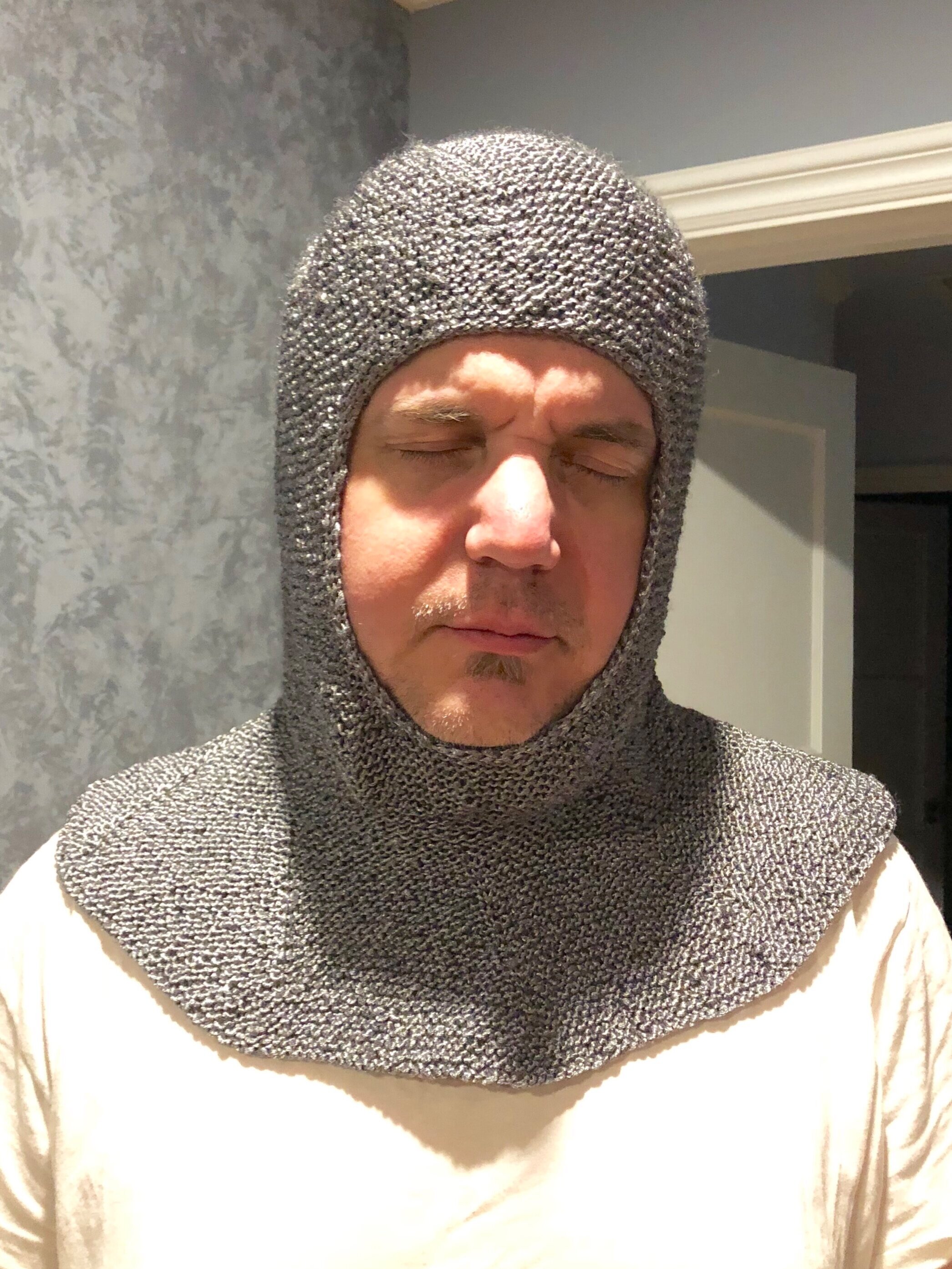16 Things You MUST Know if You Want to Knit or Crochet for the Film Industry (Part 2 of 3)
Knit sweater for the movie Annabelle Comes Home.
DISCLOSURE
This page may contain affiliate links. Working with affiliates helps me cover the costs of running a website and providing free content for all you awesome people. If you make a purchase on my website, it is possible that a small percentage of the sale will go directly to me (at no additional cost to you). All opinions remain my own.
In this second piece of my three-part series, I continue to help answer the question, “How can I get work knitting or crocheting for the movies?” If you don’t function on little to no sleep and struggle with the details, be prepared to cringe a bit!
february 16, 2021 (Updated April 17, 2021)
A sweater I embellished for the Steve Carell Xfinity commercial. Full blog about that job is here.
If you haven’t read the previous article, head over here and catch up on the first five tips. All 16 of these tips are important and I don’t want you to miss out on anything!
As I continue on with the 16 things you must know for this crazy job, I hope you aren’t too exhausted. One thing I do want to mention here is that you need to remember that if you have a hobby that you love, it changes once you transition into it becoming work. If you want to continue to love knitting and crocheting, be aware that your relationship with the yarn and the needles or hook will transform into a new kind of love/hate/but still mostly love (most of the time) relationship.
I absolutely still love to knit and crochet, but my tolerance for knitting the candle at both ends and my work/life boundaries have changed. I used to take my knitting everywhere I went and happily stitched away if I was watching a movie, walking around an aquarium, or even going on a hike. I find that I don’t bring my work with me as much as I used to. If I’m not on a deadline and we want to go see a movie, sometimes I will just leave the knitting in the car and use that time to relax and unwind. (Hmm, let me be honest about that—I ALWAYS have my knitting with me, so it’s probably sitting on the chair next to me, not banished to the car!) But during those unwind times when I do stitch away, I have a project that is no-brainer knitting, using delicious hand-dyed yarn, and is nothing but fun to work on because my fingers really do love to keep busy.
My motto used to be if I’m sitting, I’m knitting . . . but now it’s really . . . if I’m sitting or standing and I’m on deadline, I’m knitting and if I’m not on deadline, I’m probably enjoying the break. In truth, I almost always have a deadline hanging over me. It has been years since I’ve had any real breaks where I have zero dates in my calendar that I have to keep an eye on. I do love that I always have work to do, but definitely enjoy it more when it is at my own pace.
The first vest and skirt combo that Mindy Kaling wore on The Mindy Project.
So, here we go. Below are 5 more of the 16 total tips that would benefit anyone who is contemplating knitting for the silver screen. Take a deep breath and enjoy!
6. Be okay with speaking up and not always giving them what they think they want.
Have enough faith in your skills and knowledge to be able to give suggestions on what you recommend might work better than what they are asking for. Yes, you absolutely want to give them what they need, but sometimes your knowledge of yarn can provide them with an option they didn’t know they had.
For example: a costume designer wanted some pieces out of cashmere, but also wanted really vivid colors. As much as I would love to work with cashmere as often as possible, I know that it doesn’t take dye as rich and vividly as 100% merino. So I sent over some cashmere swatches in the deepest colors I could find and I also sent over some merino swatches. Merino takes dye deeply which creates a much more vibrant fiber. We went with the merino because it gave the brightness that was desired and since feel-o-vision isn’t a thing (yet), nobody on the other side of the screen would really even know what the fiber content was.
(As a side note, while we are talking cashmere: Not all cashmere is created equal. Cashmere from China is very different than cashmere from Mongolia. In China, they sheer their goats more often than they should which leads to shorter fibers. Shorter fibers means much more pilling in high friction areas of a garment. So if a cashmere sweater needs to be worn by a character for a long period of time, those armpits are gonna pill up really fast and the costume designer is not going to be happy about that!)
But in the end, they ultimately make the decisions, so if they want cashmere above anything else, you bite that bullet (which is really hard to bite in this case, right?!) and you give them high quality cashmere!
Sending over colorful swatches to costume designer, Sal Perez, for pieces to be worn by Mindy Kaling on The Mindy Project.
7. Know that the timeline is unpredictable.
It is crazy exciting to receive a call or email from a costume designer that says, “I have a project I’d love to talk to you about!” Boom! The excitement kicks in. So you talk or email back and forth and work out some of the details of the project. Then you might hear nothing for a week or two, or maybe a month or more goes by . . . You wonder, “Did I lose the job?” “Did they go with someone else?” “Did they go another direction?”
This is more common than not. But it’s okay! There are so many people involved in every aspect of making a movie. Sometimes they are deciding on colors. Sometimes they are changing casting. Sometimes the script is changing. Sometimes they are determining what is happening in the scene and whether or not this is the place for a hand knit sweater or an off the rack outfit.
(Side note on this: If the actor is doing a scene where they get soaked in the rain or pushed into the mud, etc., they aren’t going to want a hand-knit piece because they would need at least a dozen replicas. Filming doesn’t take a break while the hand knit is carefully washed and dried. They have to take it off the actor, get them into an identical outfit and then film another take and push them into the mud again.)
So after weeks (sometimes months!) of not hearing anything, I’ll suddenly get a call that they got the green light and they need the sweater by Friday. This is not always the case, but it is also not an exaggeration. I have literally been told, “We aren’t filming this for a few months, so we have time,” and then, “Okay, yeah, we need this piece by the end of the week.”
To be totally honest, I kinda love this aspect of the job because I work really well under high-pressure deadlines. I enjoy the challenge, but it is not a stress that everyone can handle. If I had to do this day after day and week after week, I’d be looking for a new career in cat cuddling or mattress testing!
A knit hood I had to make in one night for the show Lucifer. You can even see my label on the piece!
8. Be okay with little to no sleep during a project.
Remember that project you thought you would have weeks to do? Now you literally have days. Oh, and you have to source the yarn, work the swatches, take your gauges, do the math, and fully design an entire piece along with alterations.
When I was younger, I could pull all-nighters at least once a week with no problem. I could function quite well on 3 hours of sleep once or twice a week. But that ship has sailed. My need for a solid 9 is on the top of my importance list. But when I have two days to knit two sweaters (true story—they were bulky sweaters, but a hand-knit sweater is a hand-knit sweater!), you better believe I’m going to see the sunrises and the sunsets until that project is done. And wow, I don’t recover like I used to!
But, I do eventually recover. I don’t have those deadlines on a regular basis. I estimate I probably pull around 10 all-nighters in a year, but that doesn’t make them sting any less! If you can’t get the piece done in the time they need—don’t take the job! It’s better to say “no” up front than say “yes” and not deliver.
My husband is a trooper. I had to wake him up at 4am to try on the hood for Lucifer to be sure it fit a male. He was less than happy, but it had to be picked up in the morning and ready to film that day.
9. Just because you think you’re done doesn’t mean you are.
When I finish a project, I send my husband to ship it off and then I climb into bed and pass the heck out. I’m usually also starving because I haven’t sat down to a real meal in days, but sleep wins out every time. Once I’ve slept for 12 hours straight, my loving husband feeds me whatever I desire (as long as he doesn’t have to actually make it!). And then just as you are finding your way back into a normal sleep routine, you wake up to a message saying, “Hey there, we need a second for the stunt double and we need it in half the time you had to make the first.”
I’m serious about this. The stunt double is rarely the exact same size as the actor and so the pattern has to be adjusted accordingly. This has happened on more than one project. But there was one project in particular where I should have said it wasn’t possible for this to be done. The first sweater took seven days to make and I had less than five to make the second. Unfortunately, that is the only project that didn’t end well and I learned from my mistake. After two all-nighters in a row, I was literally hallucinating and couldn’t complete it in time. I wish I had handled it differently, but I learned that I needed to speak up if I was mostly sure it couldn’t be done. I promised myself not to ever let that happen again.
So don’t pop the champagne until you know the film is in the can and your job is truly done!
A sweater I embellished on for the Steve Carell Xfinity commercial, The Greatest Gift. Read the write up I did for that project here.
10. Take insanely detailed notes.
You don’t have to write them for anyone else to decipher, but you sure as heck better write them so that you can understand them later and exactly match the piece you just sent off. I have had to make two, three, four, or more of the exact same pieces and so I need to know precisely what I did on the first one. I also sometimes have to make slight alterations because a sleeve needs to be a bit longer or a neck needs to be a bit wider. Make sure you take those notes as well because it is very easy to tink out the part that needs to be changed, make the alterations, and send it off without adjusting your notes on what you just did (ask me how I know!).
I don’t know if you are like this, but I have this silly part of me that thinks, “Oh, I’ll remember what needles I used.” WRONG! Seriously, how many numbers roll through your head when you are knitting? And multiply that by ten when you are designing. You aren’t going to remember, Smarty Pants! Especially when something like COVID hits the world and eight months after you make the first one, they call you up to make another one. If you can remember what needle you used on that one project eight months ago, then I would like to know what dietary supplements you are taking for such an amazing memory!
WRITE IT DOWN! (I’m yelling that to myself . . . not at you!)
And there you go! That is 5 more tidbits of knowledge to ponder when considering if this is the right job for you. By now, I’m sure you are noticing a trend in these tips. Knowledge and speed. There is a lot to know and little time to figure it out if you don’t. I’m not trying to scare anyone off, but I am keeping it real so that you know what to expect if you seek out this kind of work and hopefully don’t make some of the same mistakes as I did.
If you found this article helpful, please feel free to pass it along. And don’t forget to follow me on Instagram and leave a comment below with any questions you might have. You can read my post about the Steve Carell Xfinity commercial I embellished a couple of sweaters for by clicking here.
Read Part Three of this Story
COPYRIGHT NOTICE
All patterns, text, and photos are owned by Krista Ann (aka KnitsyKnits, aka Explore with Knitsy). Any content from this website may not be copied for the purpose of redistribution for online or in print without written authorization from Krista Ann. If you would like to share a pattern or written content, please provide recipient with a link to the website. You may sell your finished products made using KnitsyKnits patterns, but please provide a direct link to the pattern in your listing. For any other use, please contact me directly. Thank you for supporting artists by using my content correctly so I can keep sharing free patterns with everyone!




















This quick and easy unisex knitted hat pattern is perfect for anyone that wants a quick knit that can thrown in your bag or glovebox and available whenever you might need it!